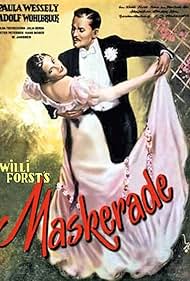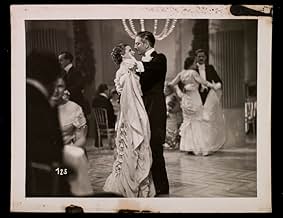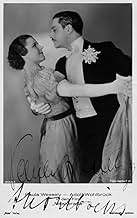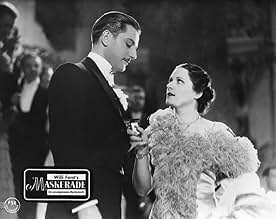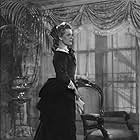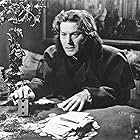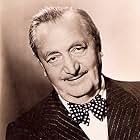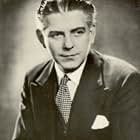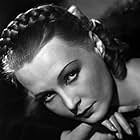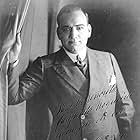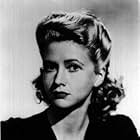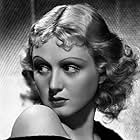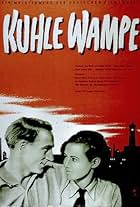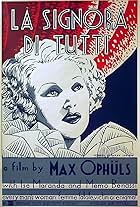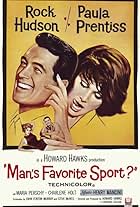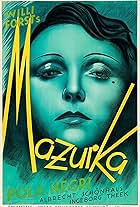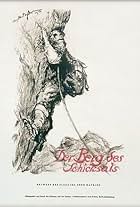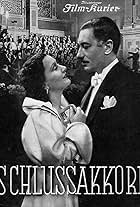Vienna 1905: A risque drawing is published and threatens to compromise the model, a doctor's wife. Artist Heideneck protects her and invents a name. But the name exists, and this respectable... Read allVienna 1905: A risque drawing is published and threatens to compromise the model, a doctor's wife. Artist Heideneck protects her and invents a name. But the name exists, and this respectable lady is drawn into the artist's shady affairs.Vienna 1905: A risque drawing is published and threatens to compromise the model, a doctor's wife. Artist Heideneck protects her and invents a name. But the name exists, and this respectable lady is drawn into the artist's shady affairs.
- Awards
- 1 nomination
Anton Walbrook
- Der Zeichner Heideneck
- (as Adolf Wohlbrück)
Hilde von Stolz
- Gerda - die Frau des Professors
- (as Hilde v. Stolz)
Julia Serda
- Die Fürstin M.
- (as Julie Serda-Junkermann)
Enrico Caruso
- Self
- (archive sound)
- (voice)
Wiener Philharmoniker
- Themselves
- (as Wiener Philharmonisches Orchester)
Josephine Rudiger
- Krankenschwester
- (uncredited)
- Director
- Writers
- All cast & crew
- Production, box office & more at IMDbPro
Storyline
Did you know
- TriviaPaula Wessely's debut.
- ConnectionsRemade as Escapade (1935)
Featured review
"Proud of my achievements? Being humble is all that is left to me in this." (Paula Wessely)
MASQUERADE IN VIENNA from the screen play by Walter Reisch is, undeniably, the most famous film that stars Paula Wessely, the actress whom Sir Laurence Olivier appreciated as a film actress among the greatest ones of the twentieth century, whose performances were studied by Bette Davis. And indeed, her captivating performance in MASQUERADE constitutes a significant factor why the film is so much worth viewing and recently released on DVD. Yet, before some deeper consideration of her charming portrayal, let me address some other aspects that make this movie a pinnacle of both Austrian and European filmmaking.
Willi Forst's movie is one of these cinematic treasures that appears to be clear, entertaining, artistic and respectful towards viewers. Actually, much of its charm we owe to Willi Forst and Walter Reisch, two people who had a decisive presence in the Austrian cinema of that time. After Forst's debut LEISE FLEHEN MEINE LIEDER about the composer Franz Schubert, MASQUERADE brilliantly combines the lovable comedy with some dramatic tensions, presents to us the atmosphere of Viennese society and within... a story of an unexpected feeling between two people who met in the most unpredictable circumstances and who overcome all and breathe life into everything, including the coldest conventions. The movie clearly manifests a unique genre that is to be called a Wiener Film and explores the undeniable talent of Mr Forst, one of the greatest directors who came from Austria except for Billy Wilder. Robert Von Dassanowsky nicely refers to this director in his book AUSTRIAN CINEMA seeing him (Forst) as "one of its greatest filmmakers...and one more casualty from the negligence that has greeted Austrian cinema since the 1950s" (p.49).
The whole atmosphere of the film can boast of truly innovative camera-work that appears remarkable in many memorable moments and Franz Planer's cinematography. It stirs and teases viewers' attention in a captivating manner. There is wit and symbolism. Consider the hilarious moment of how people read and spread a gossip...with animal sounds. Moreover, the number of juxtaposing images together with certain close-ups (including feet and steps), the static camera at ball scenes, the lighting on Paula Wessely's face as well as some highlighted pieces of wardrobe (a chinchilla muff that plays a decisive role in the storyline) are only some of the significant visual merits. Some moments are so beautifully photographed that you can hardly find something equal elsewhere. What I mean here are three scenes: the mask ball, the tea party at Fuerstin and the blissful finale (not to spoil much... just consider the use of snow). A bonus for curiosity and entertainment is added by Enrico Caruso's voice recorded on soundtrack. However, let me now refer to, perhaps, the crucial virtue of MASQUERADE - performances or rather the Performance of PAULA WESSELY.
I have discovered Ms Wessely thanks to my friend and MASQUERADE was my first encounter with this wonderful Viennese actress. I was overwhelmed by her performance. Yes, after all these years, she still enchants us and still touches us. Why? Because her role of one Miss Leopoldine Dur (a name picked randomly and hilariously) is so genuine and her performance so heartfelt. She convincingly portrays 'Die Kleine Person' (a little person) who barely represents the glamor of the high society; yet, a young person who once starts to believe in herself and pushes through to meet her destiny. 'Can an artist find any inspiration in a kind of person I am? A shy little innocent person while there are so many prettier ones? Why me? Actually, WHY NOT...ME? The character partly resembles Ms Wessely herself who wins our hearts not by the distance and self-respect but openness and respect towards others, towards people, her viewers she has always searched...and found. Besides her scene at the mirror that appears to be a sort of turning point for the entire story and, particularly, for her character, her best scene includes the innocent entrance into the artist's studio with quite different expectations than what she found out, actually and scenes she plays opposite Olga Tschechowa near the final moment.
Other cast constitute no lesser effect. While Wessely's leading man Anton Walbrook as Heideneck does not captivate us to the extent we would, perhaps, wish...their scenes are worth consideration. Among many, it is foremost the lovely waltz scene that has become, in a way, a landmark of the film, much due to the aforementioned excellent camera-work. Mr Walbrook, if not a captivating leading man for Wessely, occurs to be acceptable at least. From the supporting cast, the performances that deserve highest attention are: Peter Petersen's Professor Carl Harrandt whose pride has to face doubts, anger and compassion; Walter Janssen's court opera director whose wit makes for the crucial humor of the script; Hilde Von Stolz's sweet blonde Gerda whose interest is directed solely onto the artist rather than art; Julie Serda Junkermann's Fuerstin M. who is only capable of looking at 'good old times' not seeing the positive events that may happen in the times of her elderly life; Hans Moser as Herr Zacharias with his Viennese accent and some typical wit that appears to be a sort of irreplaceable entertainment. Finally, it is Olga Tschechowa whose villainous intrigues make for an unexpected climax of events. Indeed, the muff was there for...something...
MASQUERADE is a highly recommended film, a milestone among Austrian cinematic achievements, a beautiful story of love where the mask of all social jealousy, strict conventions and anger give in before the genuine feeling which makes all things as pure as snow. But MASQUERADE, for me, constitutes yet another pearl, something more than just a great film...a loving memory of Paula Wessely whom people still discover though she is with us in a different way.
MASQUERADE IN VIENNA from the screen play by Walter Reisch is, undeniably, the most famous film that stars Paula Wessely, the actress whom Sir Laurence Olivier appreciated as a film actress among the greatest ones of the twentieth century, whose performances were studied by Bette Davis. And indeed, her captivating performance in MASQUERADE constitutes a significant factor why the film is so much worth viewing and recently released on DVD. Yet, before some deeper consideration of her charming portrayal, let me address some other aspects that make this movie a pinnacle of both Austrian and European filmmaking.
Willi Forst's movie is one of these cinematic treasures that appears to be clear, entertaining, artistic and respectful towards viewers. Actually, much of its charm we owe to Willi Forst and Walter Reisch, two people who had a decisive presence in the Austrian cinema of that time. After Forst's debut LEISE FLEHEN MEINE LIEDER about the composer Franz Schubert, MASQUERADE brilliantly combines the lovable comedy with some dramatic tensions, presents to us the atmosphere of Viennese society and within... a story of an unexpected feeling between two people who met in the most unpredictable circumstances and who overcome all and breathe life into everything, including the coldest conventions. The movie clearly manifests a unique genre that is to be called a Wiener Film and explores the undeniable talent of Mr Forst, one of the greatest directors who came from Austria except for Billy Wilder. Robert Von Dassanowsky nicely refers to this director in his book AUSTRIAN CINEMA seeing him (Forst) as "one of its greatest filmmakers...and one more casualty from the negligence that has greeted Austrian cinema since the 1950s" (p.49).
The whole atmosphere of the film can boast of truly innovative camera-work that appears remarkable in many memorable moments and Franz Planer's cinematography. It stirs and teases viewers' attention in a captivating manner. There is wit and symbolism. Consider the hilarious moment of how people read and spread a gossip...with animal sounds. Moreover, the number of juxtaposing images together with certain close-ups (including feet and steps), the static camera at ball scenes, the lighting on Paula Wessely's face as well as some highlighted pieces of wardrobe (a chinchilla muff that plays a decisive role in the storyline) are only some of the significant visual merits. Some moments are so beautifully photographed that you can hardly find something equal elsewhere. What I mean here are three scenes: the mask ball, the tea party at Fuerstin and the blissful finale (not to spoil much... just consider the use of snow). A bonus for curiosity and entertainment is added by Enrico Caruso's voice recorded on soundtrack. However, let me now refer to, perhaps, the crucial virtue of MASQUERADE - performances or rather the Performance of PAULA WESSELY.
I have discovered Ms Wessely thanks to my friend and MASQUERADE was my first encounter with this wonderful Viennese actress. I was overwhelmed by her performance. Yes, after all these years, she still enchants us and still touches us. Why? Because her role of one Miss Leopoldine Dur (a name picked randomly and hilariously) is so genuine and her performance so heartfelt. She convincingly portrays 'Die Kleine Person' (a little person) who barely represents the glamor of the high society; yet, a young person who once starts to believe in herself and pushes through to meet her destiny. 'Can an artist find any inspiration in a kind of person I am? A shy little innocent person while there are so many prettier ones? Why me? Actually, WHY NOT...ME? The character partly resembles Ms Wessely herself who wins our hearts not by the distance and self-respect but openness and respect towards others, towards people, her viewers she has always searched...and found. Besides her scene at the mirror that appears to be a sort of turning point for the entire story and, particularly, for her character, her best scene includes the innocent entrance into the artist's studio with quite different expectations than what she found out, actually and scenes she plays opposite Olga Tschechowa near the final moment.
Other cast constitute no lesser effect. While Wessely's leading man Anton Walbrook as Heideneck does not captivate us to the extent we would, perhaps, wish...their scenes are worth consideration. Among many, it is foremost the lovely waltz scene that has become, in a way, a landmark of the film, much due to the aforementioned excellent camera-work. Mr Walbrook, if not a captivating leading man for Wessely, occurs to be acceptable at least. From the supporting cast, the performances that deserve highest attention are: Peter Petersen's Professor Carl Harrandt whose pride has to face doubts, anger and compassion; Walter Janssen's court opera director whose wit makes for the crucial humor of the script; Hilde Von Stolz's sweet blonde Gerda whose interest is directed solely onto the artist rather than art; Julie Serda Junkermann's Fuerstin M. who is only capable of looking at 'good old times' not seeing the positive events that may happen in the times of her elderly life; Hans Moser as Herr Zacharias with his Viennese accent and some typical wit that appears to be a sort of irreplaceable entertainment. Finally, it is Olga Tschechowa whose villainous intrigues make for an unexpected climax of events. Indeed, the muff was there for...something...
MASQUERADE is a highly recommended film, a milestone among Austrian cinematic achievements, a beautiful story of love where the mask of all social jealousy, strict conventions and anger give in before the genuine feeling which makes all things as pure as snow. But MASQUERADE, for me, constitutes yet another pearl, something more than just a great film...a loving memory of Paula Wessely whom people still discover though she is with us in a different way.
- marcin_kukuczka
- Sep 13, 2011
- Permalink
Details
- Runtime1 hour 30 minutes
- Color
- Aspect ratio
- 1.37 : 1
Contribute to this page
Suggest an edit or add missing content

